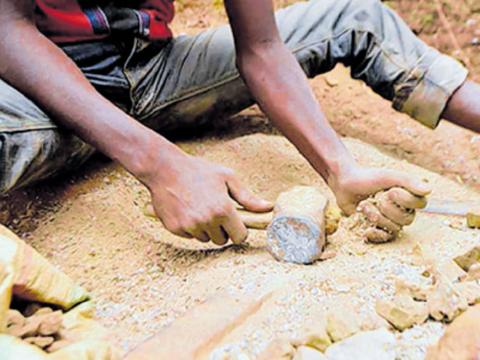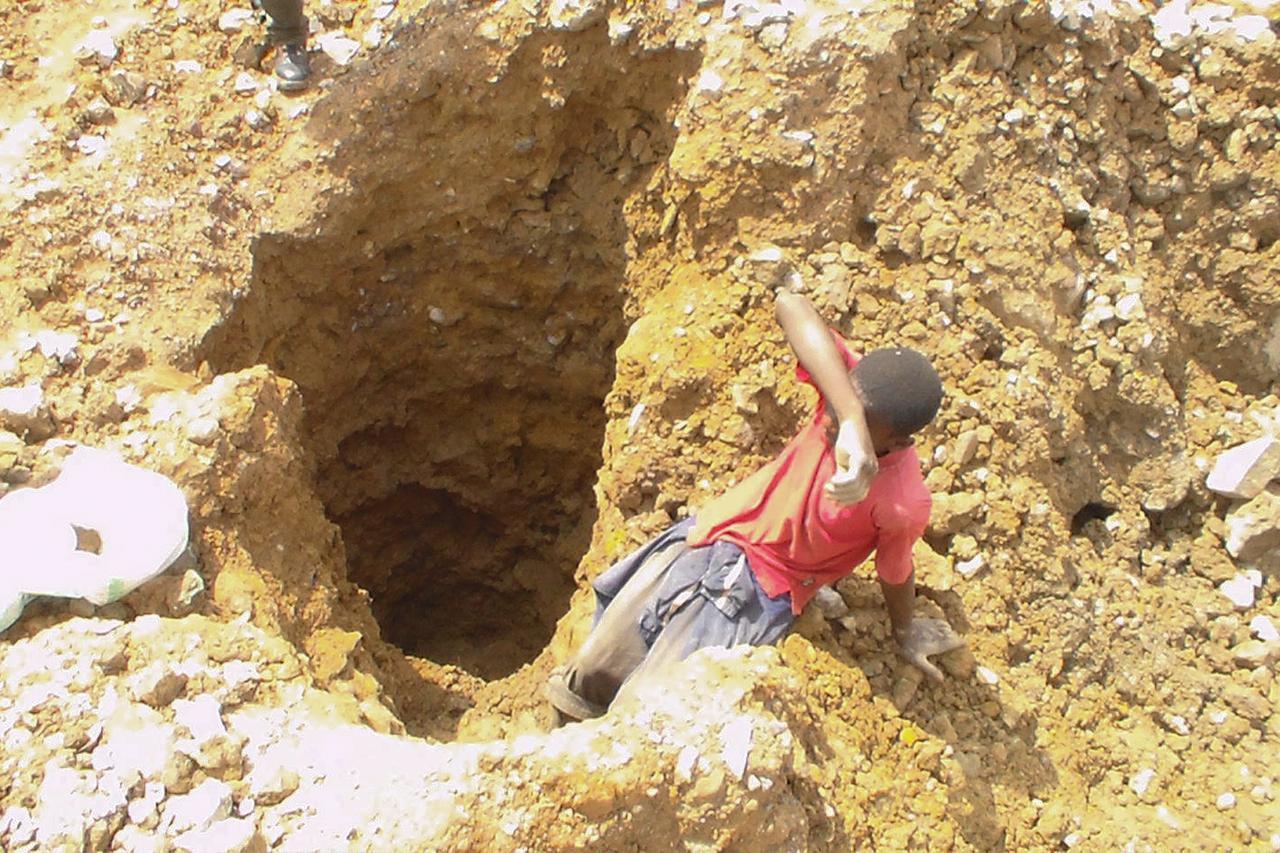Rescuing and supporting children forced into illegal mining in Uganda

As the sun rises, casting long shadows over Tiira trading centre, 14-year-old Victor strolls calmly, making his daily journey from his village to the local mine where he works. Adorning torn clothes, barefoot, laced with chemicals used in mining, and carrying a bucket in one hand and a rusty machete in the other, Victor explains what attracted him to the mine from such a young age.
"I started mining when I was 10", he says. "I started working here [in the gold mine] because I am looking for money. I dropped out of my sixth year of primary school after my parents could not pay for my uniform and other school requirements. I joined my friends here to find work. Maybe I will return to school someday if I make enough money."
Like Victor, Samuel's journey has been fraught with challenges. "I used to work in the mines [when I was as young as] 11 years old. I was not studying because most of the time I was at the mine. I always thought [earning] money was better than going to school; that is why I spent my time there", says a 15-year-old former child miner.
Gold makes 44% of Uganda's export earnings. The precious metal has overtaken coffee to become the most important export commodity in recent years, with cumulative revenues totalling UGX3 trillion (US$1.7 billion) between December 2019 and November 2020, according to data from the Bank of Uganda.

But behind this lucrative business lurks a desperate daily battle for survival--child miners like Victor and Samuel bearing the heaviest load. The impact of the work on a child's health and education is significant.
"Since working here, I have problems with my skin, body pains, and pain in my eyes," says Victor, who works alongside his mother in a gold mine at Tiira in Busia district for barely a meal a day. The heavy work can permanently damage a growing child's brain, bones and muscles. Minerals are often hazardous, and exposure to some of these materials can have profound health effects.
The lure of the money
Working in independent mines has many dangers for young and old alike, including a lack of health and safety regulations, the absence of proper tools and equipment, disease, and meagre financial reward. But the lure of money is an easy choice for children from poor rural families, even at the expense of their education.
Harriet Ariko, Community Development Officer for Busitema sub-county, has witnessed poverty levels increase, with most families unable to take care of their children or keep them in school. "Most of the young people in this village have been married to the environment", she says. "Most of them do not see the long-term importance of education. They see their peers with money from the mines, which influences them to stop attending school altogether and go to find the money."
Victor and Samuel's stories are familiar in the mining communities where economic opportunities are limited, and people are understandably drawn toward any promise of money as there are few other sources of employment. Children are involved in mining work primarily due to poverty, lack of alternate opportunities and ignorance of the law prohibiting child work in the mines. The dire situation increases family vulnerabilities, forcing women to subsidise their income through prostitution. Children, especially girls, are also compelled into sex work to survive.
Mining is one of the worst forms of child labour. Many young people do not have a light for their future despite several years of working in mines. And that, says Raphael Oram, Probation Officer for Busia district, is their biggest fear as community leaders—children slipping into child labour and the devastating cycle of poverty.
"So, it's a long-term [issue] that needs a lot of resources", she says. "It's an issue that if it's not dealt with at the earliest, it's going to affect the future human resource of a nation—of a whole continent—because we are getting a generation of children who are missing out totally on education."
The reality and the laws
Uganda has strict laws to prevent children from working in mines, and the policy ensuring free education has reportedly positively reduced child labour. The minimum age for hazardous work is 18 years.
But, with the fragile economy, these laws and occasional police raids have been inadequate in keeping children from working in artisanal gold mines. Around 1 million children aged between five and 17 years work in mines worldwide, and the number is still increasing, according to the International Labour Organisation (ILO).
In Uganda, the statistics are not readily available, but as many as 30 percent of those who labour in the mining sector are estimated to be children. Health and other hazards abound, but some parents at the mines argue that children should be allowed to work because they lighten the burden and help provide vital income. Children from families living near mines who fail to attend school are involved in mining as they feel this is the only opportunity to make money. These children are in precarious situations that do not bode well for their rights and welfare.
Of course, in areas of extreme poverty, a normal education for most children is still a dream, and there is no end to the desperation. As Samuel's mother explains, the long-term benefit of education may seem far away.
"We're not happy that our children work in the mines, but our problems make it necessary", she says. "Look how we live. As you can see, we barely get by. Children help us survive. That's why we allow them to try their luck in the mines. We do sympathise with them, but we have to bear it. Also, we don't want our family to blame us for neglecting our children."
World Vision helps rescue child miners
Child miners in Uganda are undoubtedly a symptom of poverty in which a lack of opportunity forces children and their families to participate in risky activities for a small reward. Despite hopes for a bright future, young people working in mines face a life without a net—their future deeply rooted in poverty statistics. "This is not a childhood with no time to play or rest," says Amos Ogari, World Vision's child protection focal person in Busia district. "This type of labour is robbing children of their childhood."
Desirous of ending all forms of violence against children, World Vision is working with children, their families, communities and local leaders in Busia to find solutions to child labour, especially in mining. "The solution has to be long-term aimed at improving livelihoods, education and prosperity of marginalised communities", says Ogari.
Through its child protection programme, World Vision is empowering families to ensure that children do not go into those holes in the mines. "We're working with families to cater for their children's health and to have all children in school and remain there—because once in school, they have a shot at a better future", says Ogari.
Already, there are success stories to celebrate. Samuel's parents might still be struggling to put food on the table, but they can rest a bit easier now that their son has returned to school for the first time in three years. At last, their son has a chance at a normal childhood.
Samuel is among nearly 100 children who, with the support of World Vision, have been rescued from the treacherous gold mines in the border district of Busia. This work has been achieved as part of World Vision's It Takes a World to End Violence Against Children campaign launched in 2017, focusing on ending child marriage, child sacrifice and violence against children.
World Vision defines violence against children as all forms of physical, sexual and mental violence, neglect or negligent treatment, maltreatment or exploitation, harm or abuse, including commercial sexual exploitation, trafficking, child labour and harmful practices, such as female genital mutilation/cutting and child marriage. Children from the mining communities need inspirational people to show them the importance of education and the possibility of them succeeding in life outside the mines.
"There are people who have been working in the mines for a long time but still don't have much", says Ariko. Many children see these pitfalls of mining, and they do not like it at all. "We need the money for school. Otherwise, I have never considered mining as safe work for me," says Victor, who still goes to the mines hoping to better his life.
It takes you and me to work together to create positive opportunities in our communities to keep children away from dangerous employment. By investing in a child's life, we will help them stay in school. We also help build up their community so that there will be more decent job opportunities for them to pursue as adults. We can do it.
When you sponsor a child, their family won't worry about where their next meal will come from or how to pay for their child's schoolbooks. It means a child can be a child, not an enslaved person. Sponsor a child and help him build a future filled with hope and success. To learn more and get involved, click here.
-
Story by Amos Ogari - Child Protection Project Officer, and Fred Ouma - Development Communications Coordinator, World Vision, Uganda